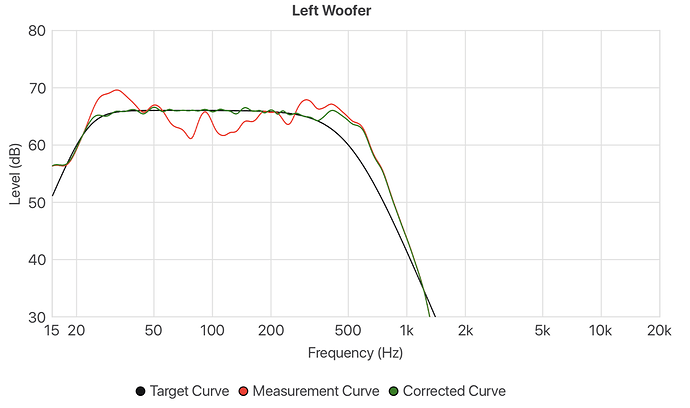The problem is that my basses in large orchestral works like symphonies lack precision. They are somewhat muddy and surely could be more distinct.
From what I read this could be caused by some room resonances in the low frequencies.
Can electronic filtering improve things? I am a layman and I had no success so far.
I use a Node2 DAC and the ROON software.
The latter allows to create filters with a DSP processing software.
I could implement for instance a “Low pass” filter.
But I had no success so far.
Do you have a recommendation as to the filters?
Type, frequencies, attenuation and slope?
Where should I start? The matter is too complex for me I need your guidance.
Thank you.
J.Driscart
Jacques,
My speakers (Martin-Logan Impression ESL 11a) and their companion ARC room correction software do a very nice jobb of this bass improvement task. I’m attaching a before and after image
from Paradigm’s ARC Genesis software yesterday. Look at the difference between the red before and the green after responses.The success here comes from smart software, frequency sweep data from multiple sample points in the room using a calibrated microphone, and playback application of the complicated frequency equalization curve. It’s success is also dependent on how poorly the room/speaker/listener trio is in the first place. (Same as makeup is not enough to make one beautiful.)
Experiment with speaker placement as a first step as this can have more effect than you think. Maybe try the Sumiko master set as starting point as it’s all about getting bass right. When exhausted this then either turn to treating the room first if you can if not then look to DSP. You can do it yourself using a calibrated mic such as Umik-1 from mini DSP or take readings and get a 3rd party such as Home Audio Fidelity help you out. Thierry does wonders.
Michael Jones and CrystalGipsy, thank you very much for your replies.
I will go for : Microphone + Audio filtering.
The good news is that improvements are very affordable.
I suppose software in this and other areas is not a panacea but you experienced that it can help and this matters to me.
“Makeup is not enough to make one beautiful”… well understood but it may contribute.
I must now investigate and choose between:
- Paradigm’s ARC Genesis software… and
- Home Audio Fidelity
and … still find a microphone.
I am retired so I have time to investigate into this.
Thanks to both of you.
Jacques
Please try speaker placement first it’s the biggest factor in any setup. It’s taken me a long time with my newish speakers to finally settle on a position I can live with both acousticaly and from a room aesthetic. Then apply the cream on top with some DSP.
Yes, to the above: best always to avoid the problem, then to minimize its remaining effect, before undertaking complicated schemes. Here that means get your speakers into a happy place (often they are too close left-right and front-back to a corner), dealing with reflections from the front wall, the floor, width between them, and toe-in angle. Then there are room treatments, then fancy DSP schemes.
To apply a filter to modify frequency range you need to measure carefully to understand the issue. This is both software + hardware.
This will give you comprehensive ways to understand the problem. Dips in low bass response are usually modal (caused by room reflections) and are difficult to fix, but peaks can be treated often with good result. Try a little at a time and see the result. Website shows out of stock but this is temporary and I have seen used.
As @Simon_Arnold3 already indicated, you approach the problem from the wrong side.
Is all bass muddy? With all kinds of music? Then the fault might lie with your speakers. Either their bass rendering is just not good, the placement is off or you have a room issue.
Is it only with specific recordings? Look no further: the recording is bad. For classical music, try to find a better performance.
If it’s your speakers’ bass performance, try borrowing a subwoofer and see if this improves things
If it’s placement: move the speakers around.
If it’s the room: try some throw pillows, rugs and general soft furnishings (they can act as bass traps) or put in a piece of furniture with compartments and put some knick-knacks in. This is an easy diffuser.
Last resort is DSP room correction. This should be done at amplifier level if at all possible.
Sources are not the best place to do room correction.
